- 1College of Animal Science and Technology, China Agricultural University, Beijing, China
- 2College of Agriculture, China Agricultural University, Beijing, China
- 3Beijing Key Laboratory for Grassland Science, China Agricultural University, Beijing, China
- 4National Energy R&D Center for Biomass, Beijing, China
- 5Beijing Sure Academy of Biosciences, Beijing, China
Melatonin serves pleiotropic functions in prompting plant growth and resistance to various stresses. The accurate biosynthetic pathway of melatonin remains elusive in plant species, while the N-acetyltransferase and O-methyltransferase were considered to be the last two key enzymes during its biosynthesis. To investigate the biosynthesis and metabolic pathway of melatonin in plants, the RNA-seq profile of overexpression of the ovine HIOMT was analyzed and compared with the previous transcriptome of transgenic oAANAT gene in switchgrass, a model plant for cellulosic ethanol production. A total of 946, 405, and 807 differentially expressed unigenes were observed in AANAT vs. control, HIOMT vs. control, and AANAT vs. HIOMT, respectively. Two hundred and seventy-five upregulated and 130 downregulated unigenes were detected in transgenic oHIOMT line comparing with control, including the significantly upregulated (F-box/kelch-repeat protein, zinc finger BED domain-containing protein-3) genes, which were potentially correlated with enhanced phenotypes of shoot, stem and root growth in transgenic oHIOMT switchgrass. Several stress resistant related genes (SPX domain-containing membrane protein, copper transporter 1, late blight resistance protein homolog R1A-6 OS etc.) were specifically and significantly upregulated in transgenic oHIOMT only, while metabolism-related genes (phenylalanine-4-hydroxylase, tyrosine decarboxylase 1, protein disulfide-isomerase and galactinol synthase 2 etc.) were significantly upregulated in transgenic oAANAT only. These results provide new sights into the biosynthetic and physiological functional networks of melatonin in plants.
Introduction
Melatonin (N-acetyl-5-methoxytryptamine) was first discovered in vertebrates (Lerner et al., 1958), then detected in higher plants (Dubbels et al., 1995; Hattori et al., 1995), and now is widely accepted of its distribution in all kingdoms, from prokaryotes to eukaryotes, from animals to plants (Manchester et al., 2000; Hardeland and Poeggeler, 2003; Simopoulos et al., 2005; Hardeland, 2015), and functions as a direct scavenger of reactive oxygen species (ROS), a mediator hormone of circadian rhythms and an activator of antioxidant enzymes (Arnao and Hernández-Ruiz, 2015; Reiter et al., 2015; Bai et al., 2015, 2016; Gao et al., 2016; Shi et al., 2016a). In plants, melatonin regulated the seed germination, growth of roots, and shoots, and development of flowering (Hernández-Ruiz et al., 2005; Zhao et al., 2013; Arnao and Hernández-Ruiz, 2015). Moreover, the responses to abiotic stresses, including extreme temperature, drought, salt, radiation, make melatonin a concerned candidate as a natural stimulator for crop cultivation (Li et al., 2012; Zhang et al., 2014a; Fan et al., 2015; Shi et al., 2015a). However, the involved regulations of the functional gene expression and physiological mechanism of melatonin biosynthesis and metabolic pathways remains poorly understood in plants (Hardeland, 2015; Zhang et al., 2014b).
The classic pathway of melatonin biosynthesis comprises four steps beginning with tryptophan, firstly decarboxylation by tryptophan decarboxylase (TDC), then N-acetylation by arylalkylamine N-acetyltransferase (AANAT) in animals/serotonin N-acetyltransferase (SNAT) in plants, and the final O-methylation by N-aceylserotonin methyltransferase (ASMT) in animal/hydroxyindole-O-methyltransferase (HIOMT) in plants (Tan et al., 2016). The last two steps are presumed as rate-limiting which are catalyzed by AANAT/SNAT and HIOMT/ASMT (Morton and Forbes, 1988; Byeon et al., 2015, 2016). Furthermore, the overexpression of rice caffeic acid O-methyltransferase (COMT) exhibited upregulation of melatonin contents in transgenic rice plants, indicating that the N-acetylserotonin methyltransferase activity was required for melatonin biosynthesis (Byeon et al., 2015). Recently, genetic engineering modifications of coding genes for melatonin biosynthesis and metabolism enzymes were applied to alter the melatonin contents in transgenic rice, tomato, Arabidopsis thaliana, and Nicotiana sylvestris (Kang et al., 2010; Okazaki et al., 2010; Park et al., 2012; Zhang et al., 2012; Wang et al., 2014; Zuo et al., 2014).
Switchgrass (Panicum virgatum) is a Poaceae warm season C4 perennial grass native to the U.S., and is regarded as a model plant of cellulosic biofuel production for its desirable characteristics, such as large biomass and strong ability to thrive in marginal areas (McLaughlin and Kszos, 2005; Keshwani and Cheng, 2009; Brown et al., 2016). Molecular breeding has made much progress toward improving biomass yield, biofuel quality, and stress resistance in switchgrass, which is the model plant for cellulose ethanol production (Bouton, 2007; Fu et al., 2011; Shen et al., 2013; Poovaiah et al., 2014; Wuddineh et al., 2015). Recently, a series of transgenic overexpression of transcriptional factor (NAC, AP2/ERF, MYB4), sucrose synthesis gene (SUS) to prompt growth (Shen et al., 2013; Poovaiah et al., 2014; Yang et al., 2014; Wuddineh et al., 2015), the inhabitation of cinnamyl alcohol dehydrogenase (CAD) to reduce the lignin content (Fu et al., 2011), and the exploration of abiotic stress related genes and miRNA (Sun et al., 2012; Sharma et al., 2015; Liu et al., 2016) were produced in switchgrass. In addition, the activities of antioxidant and free radical scavenger for melatonin provide opportunities for prompting growth and development in plants (Arnao and Hernández-Ruiz, 2015; Reiter et al., 2015; Shi et al., 2016a). The exogenous applications of melatonin exhibited the enhanced seed germination in cucumber (Zhang et al., 2014a), lateral root formation in both Brassica juncea (Chen et al., 2009) and cucumber (Zhang et al., 2014c), and salt resistance in soybean plants (Wei et al., 2015) etc. Other studies revealed that melatonin also exercised some control over root architecture as observed in St. John's Wort, wild leaf mustard, sweet cherry root stocks, and lupin (Murch et al., 2001; Arnao and Hernández-Ruiz, 2007; Chen et al., 2009; Sarropoulou et al., 2012). Moreover, the endogenous modifications of related genes to gain the melatonin-rich plants displayed cold resistance in rice (Kang et al., 2010), the drought-tolerant phenotypes of tomato (Wang et al., 2014) and A. thaliana (Zuo et al., 2014). Here, the HIOMT gene encoding the last enzyme in melatonin biosynthesis pathway was overexpressed in switchgrass, and the transcriptomic profile was analyzed in order to disentangle the melatonin biosynthesis pathway and also the potential functions of melatonin in plants.
Materials and Methods
Plant Materials and Morphological Traits
Transgenic switchgrass (cultivar Alamo) lines expressing ovine HIOMT gene (ID: JF815374.1) were grown under 16 h light (26°C, 120 μmol/m2/s) and 8 h dark (18°C) conditions in greenhouse. Fully matured plants were chosen from each genotype for molecular characterization and transcriptome sequencing. Three replicates of stems for each transgenic line and in total six (three transgenic HIOMT (H) lines: H1, H2, H3, and three transgenic empty vector (EV): EV1, EV2, and EV3) were collected and frozen in liquid nitrogen and stored at 80°C until analysis. The t-test was applied to compare the differences of the morphological traits between transgenic oHIOMT lines and control.
At the transgenic reproductive third (R3) stage (Hardin et al., 2013), the tiller number, plant height, stem node number, internode length, internode diameter, leaf blade length, leaf blade width, root number, root length, root diameter, and spike length were determined (Figure 1). The third internode was chosen for measuring internode diameter. Leaf blade length and leaf blade width of third internode were measured. Twelve replicates were randomly sampled for each transgenic line.
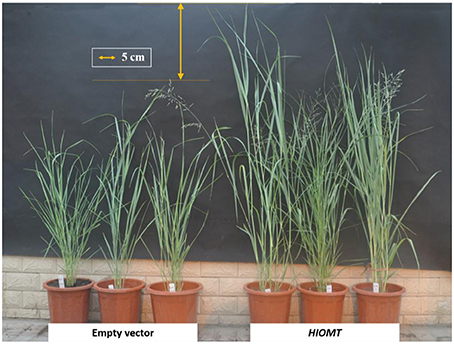
Figure 1. Phenotypes of the transgenic HIOMT switchgrass comparing with the transgenic empty vector (EV).
RNA Isolation and Qualification
Total RNA was extracted from the sampling stems using Trizol method (Invitrogen, Carlsbad, CA, USA). RNA purity and integrity were assessed using the NanoPhotometer® spectrophotometer (IMPLEN, CA, USA) and Agilent Bioanalyzer 2100 system (Agilent Technologies, CA, USA), respectively. RNA concentration was measured using Qubit® RNA Assay Kit in Qubit® 2.0 Flurometer.
Transcriptome Preparation
The 1.5 μg RNA per sample was prepared for the RNA-seq. Sequencing libraries were generated using NEBNext® Ultra™ RNA Library Prep Kit for Illumina® (NEB, USA). The cDNA fragments of 150~200 bp were selected from the library by purification with AMPure XP system (Beckman Coulter, Beverly, USA).
Clustering
The clustering of the index-coded samples was performed on a cBot Cluster Generation System using TruSeq PE Cluster Kit v3-cBot-HS (Illumia). After cluster generation, paired-end reads were generated by sequencing with the library preparations on an Illumina Hiseq platform.
Validation of RNA-seq Data by Real-Time Quantitative
RNA-seq results were validated by Real-time quantitative PCR of 16 different genes using 7500 Real-Time PCR System (Applied Biosystems) (primer sequences please see Supplementary Table 1). Gene expression levels were calculated by the 2-ΔΔCt method (Livak and Schmittgen, 2001). Each plate was repeated three times in independent runs for all reference and selected genes.
Data Analysis
Quality Control
After removing the adapter containing reads, ploy-N containing reads and low quality reads, clean data/clean reads were obtained from raw data. Meanwhile, the Q20, Q30 values, GC-contents, and sequence duplication level of the clean data were calculated (Supplementary Table 2). The RNA-seq raw data have been submitted to NCBI SRA dataset (http://www.ncbi.nlm.nih.gov/bioproject), and the project accession number is PRJNA322585.
Transcriptome Assembly and Gene Functional Annotation
De novo transcriptome assembly was constructed and accomplished for the incomplete genome of switchgrass using Trinity with min_kmer_cov set to 2 and all other parameters set default (Grabherr et al., 2011). Gene function was annotated based on the following databases: Nr (NCBI non-redundant protein sequences); Nt (NCBI non-redundant nucleotide sequences); Pfam (Protein family); KOG/COG (Clusters of Orthologous Groups of proteins); Swiss-Prot (A manually annotated and reviewed protein sequence database); KO (KEGG Ortholog database); GO (Gene Ontology).
Differential Expression Analysis
Gene expression levels were calculated by RSEM (Li and Dewey, 2011). To reveal the transcriptionally regulatory event occurring during the transgenic process, comparative transcriptomic analysis was performed among the pools of control and the two transgenic (oAANAT and oHIOMT) RNA samples. Only the genes with a P-value-adjusted (padj) < 0.05 were identified as being significantly changed by the Benjamini and Hochberg's approach.
GO Enrichment Analysis and KEGG Pathway Enrichment Analysis
Gene Ontology (GO) enrichment analysis of the differentially expressed genes (DEGs) was implemented by the GOseq R packages based Wallenius non-central hyper-geometric distribution (Young et al., 2010), which can adjust for gene length bias in DEGs. KEGG (Kanehisa et al., 2008) is a database resource for understanding high-level functions and utilities of the biological system, such as the cell, the organism, and the ecosystem, from molecular-level information, especially large-scale molecular datasets generated by genome sequencing and other high-throughput experimental technologies (http://www.genome.jp/kegg/). The KOBAS software was performed to test the statistical enrichment of differential expression genes in KEGG pathways (Mao et al., 2005).
Results
Promoted Vegetative and Reproductive Growth
To compare the effects of HIOMT gene during the biosynthesis processes, the phenotypic traits were measured. Transgenic HIOMT switchgrass exhibited significant promotion of growth comparing with EV (Figure 1; Supplementary Table 3). Average plant height and internode length were 35.6 and 52.9% higher in HIOMT (90.60 and 13.43 cm) than that of EV (66.81 and 8.78 cm, respectively, P < 0.05). Stem node number of HIOMT was 15.6% higher than that of EV (P > 0.05). There was no significant difference in internode diameter between the two groups (P > 0.05). Average leaf blade length was 20.7% longer in HIOMT (52.53 cm) than that of EV (43.53 cm, P < 0.05). Root number, root length and root diameter of HIOMT were 75.8, 18.3, and 39.4% larger than those of EV, respectively (P < 0.05). Spike length in HIOMT (19.5 cm) was nearly 4-fold of the EV (5.4 cm, P < 0.01).
Differential Expression Profiling between Transgenic oHIOMT and EV Lines
To analyze the similarities and differences in the transgenic transcriptome, a hierarchical clustering was represented and indicated the significant differences in transcripts of all of the DEGs in the three replicates of the control and two transgenic groups (Figure 2). After calculating the expression level of each mapped unigene, a total of 1556 unigenes were detected that had levels of expression that were significantly different among the two transgenic and control libraries. The 946, 405, and 807 differentially expressed unigenes were observed in AANAT vs. EV, HIOMT vs. EV, and AANAT vs. HIOMT, respectively (Figure 3). A total of 183 genes were differentially expressed in both AANAT vs. EV and HIOMT vs. EV, but not significantly different in AANAT vs. HIOMT. Three unigenes overlapped with all three groups, including c52804_g3 (hypothetical protein), c56995_g3 (O-methyltransferase), c56995_g4 (ribosomal protein). One hundred twenty nine unigenes were upregulated in both transgenic oAANAT and oHIOMT comparing with EV, while 55 unigenes were downregulated. There were 145 and 76 genes that significantly upregulated and downregulated in transgenic oHIOMT, respectively, but not differentially expressed in transgenic oAANAT. Comparatively, there were 607 and 153 genes that significantly upregulated and downregulated in transgenic oAANAT, while not differentially expressed in transgenic oHIOMT (Supplementary File 1). Twenty-five unigenes specifically and differentially expressed in HIOMT, including 13 upregulated (c64524_g1, c52718_g1: glycine-rich domain-containing protein 1-like; c43728_g1: Bowman-Birk type wound-induced proteinase inhibitor WIP1-like; c62742_g1: SPX domain-containing membrane protein) and 12 downregulated ones (c46269_g1: NAC domain-containing protein 67-like; c61012_g1: protein tyrosine kinase) comparing with AANAT and EV (Supplementary File 1).
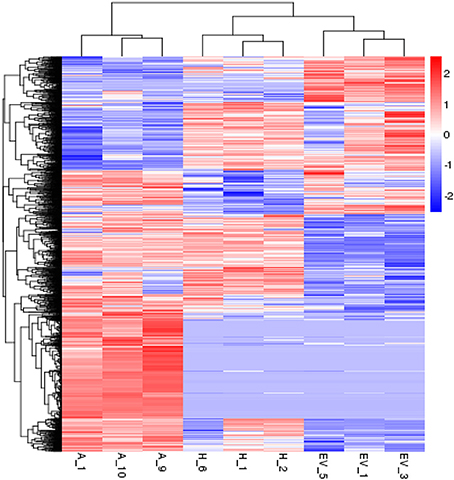
Figure 2. Hierarchical clustering of the differentially expressed genes, using the RNA-seq data derived from three groups (A: AANAT, H: HIOMT, and EV: empty vector, hereafter) based on log10 RPKM values.
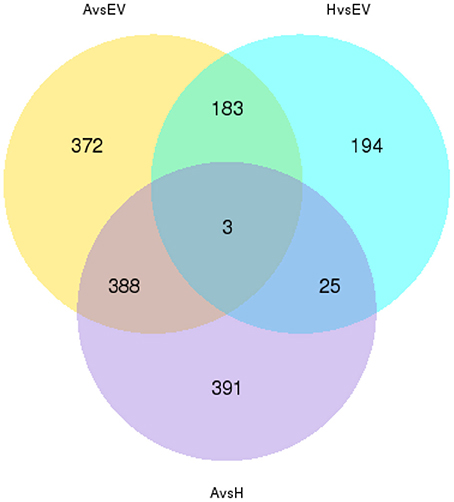
Figure 3. Venn diagram showing the number of differentially expressed genes between every two samples and the number of joint differentially expressed genes.
Functional Classification of the DEGs by Gene Ontology Analysis
Among all differentially expressed unigenes, 1071 were upregulated among the three libraries, and 513 were downregulated. However, only 511, 193, and 504 unigenes were functionally annotated with GO terms in AANAT vs. EV, HIOMT vs. EV, and AANAT vs. HIOMT, respectively, revealed by DEG analysis were functionally assigned to the relevant terms in three categories (Biological Process, Cellular Component, and Molecular Function) of the GO database (Figure 4). The GO terms “organonitrogen compound biosynthetic process,” “oxidoreductase activity,” “NAD(P)H oxidase activity,” growth factor activity, and “hyperosmotic response” were highly enriched in the DEGs. At the same time, other terms that were related to the response to various other types of abiotic and biotic stresses, such as SOS response “phototropism,” “cellular response to external stimulus,” and “response to external stimulus,” were also highly enriched in the DEGs.
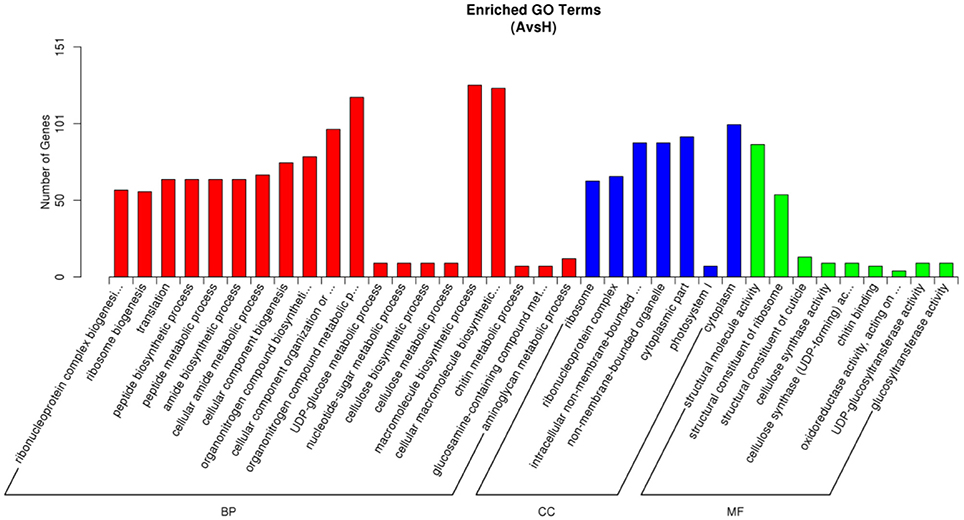
Figure 4. GO classifications of DEGs between transgenic AANAT and HIOMT lines in three main categories: biological process (BP), cellular component (CC), and molecular function (MF).
By comparing transgenic AANAT vs. EV, 2012 GO terms were DEGs, including 1687 upregulated and 1094 downregulated GO items. The GO terms of the “peptide metabolic process” and “amide biosynthetic process” in Biological Process and “structural molecule activity” in Molecular Function were significantly overrepresented (Figure 4). By comparing transgenic HIOMT vs. EV, 1314 DEGs, including 724 downregulated GO items and 1062 upregulated GO items, were functionally assigned to the relevant terms; “metabolic process” in Biological Process was significantly overrepresented, followed by “oxidation-reduction process” in Biological Process and “oxidoreductase activity” in Molecular Function. Notably, none of the GO terms was significantly enriched after multiple testing corrections (corrected P > 0.05) in HIOMT vs. EV. Considering the AANAT vs. HIOMT, 1904 DEGs, including 1493 upregulated and 1126 downregulated GO items, were significantly overrepresented of the “macromolecule biosynthetic process” and “cellular macromolecule biosynthetic process” in Biological Process, “cytoplasm,” and “cytoplasmic part” in Cell Component, and “structural molecule activity” and “structural constituent of ribosome” in Molecular Function (Figure 4).
KEGG Pathway Analysis of the Melatonin-Related Genes
The 50 pathways were identified between the HIOMT vs. EV from the KEGG database, with 36 upregulated and 17 downregulated pathways (Figure 5). The DEGs were significantly enriched in “homologous recombination,” “mineral absorption,” “isoquinoline alkaloid biosynthesis,” “tropane, piperidine, and pyridine alkaloid biosynthesis,” “nitrogen metabolism,” “flavonoid biosynthesis,” “steroid biosynthesis,” “alpha-Linolenic acid metabolism,” “tyrosine metabolism,” and “beta-Alanine metabolism.” The top 20 obviously enriched pathways are shown in Figure 5. Specifically, the photosynthesis-antenna proteins pathway, MAPK signaling pathway and oxidative phosphorylation were significantly upregulated in KEGG pathway maps during the transgenic oAANAT line. While nitrogen metabolism, flavonoid biosynthesis, beta-Alanine metabolism, Brassinosteroid biosynthesis, Phenylalanine metabolism, and Ascorbate and aldarate metabolism were significantly upregulated in transgenic oHIOMT line comparing with EV (Supplementary File 2). Furthermore, a total of 166 pathways, with 141 upregulated and 66 downregulated pathways, represented the DEGs between AANAT and HIOMT groups, including “ribosome,” “oxidative phosphorylation,” “photosynthesis,” “DNA replication” and “calcium signaling pathway.”
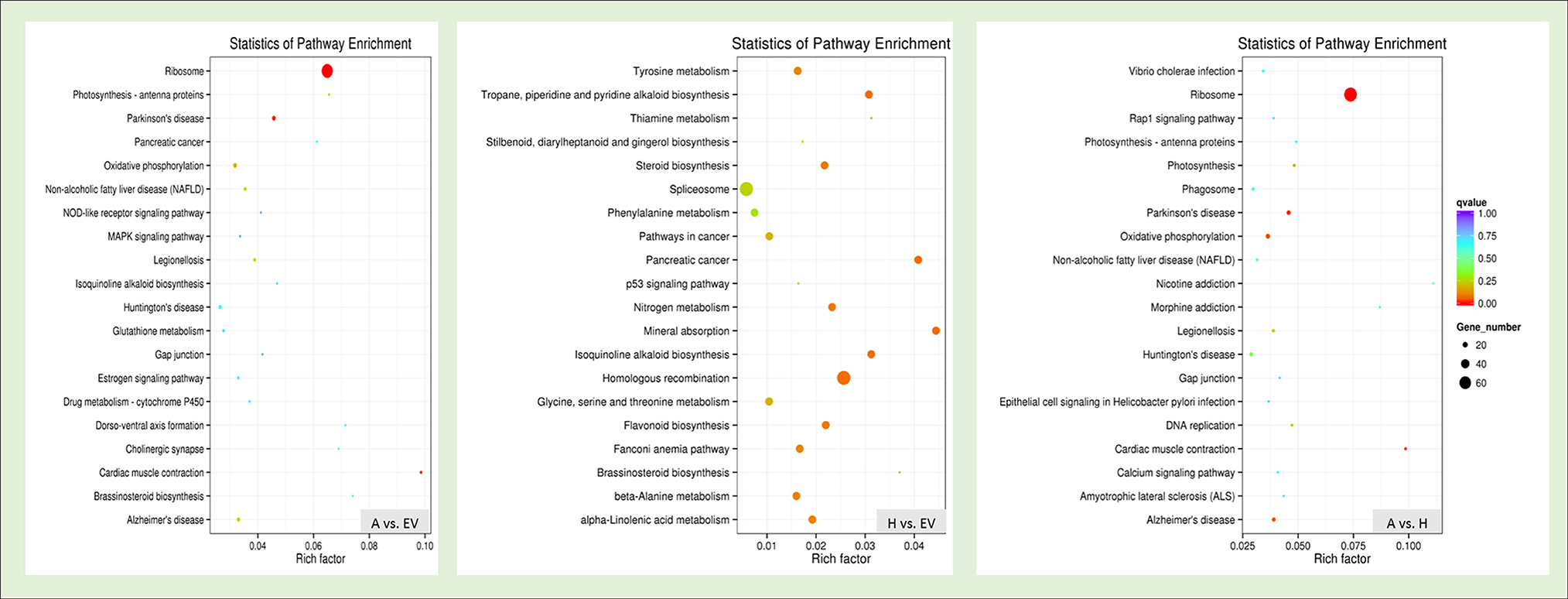
Figure 5. KEGG enrichments of the annotated DEGs across three comparisons. The left Y-axis indicates the KEGG pathway. The X-axis indicates the Rich factor. A high q-value is represented by blue, and a low q-value is represented by red.
Validation of Gene Expression Profiles Using RT-qPCR
The 16 DEGs were selected to evaluate the different expressions for qRT-PCR. Total RNA samples extracted from switchgrass leaves at reproductive stages were used as templates. Histograms were generated by comparing the FPKM determined by transcriptome analysis and qRT-PCR. Expression quantities of the selected genes using RT-qPCR were consistent with the results obtained with RNA-Seq analysis, which means the RNA-seq data were credible. (R2 = 0.861 for AANAT, R2 = 0.933 for HIOMT, P < 0.01) (Figure 6).
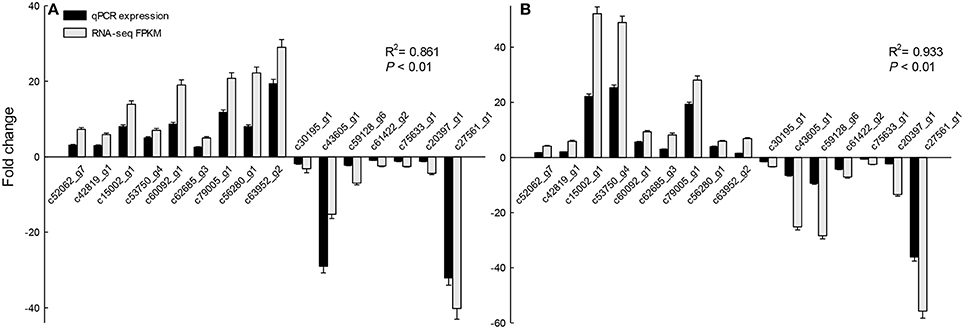
Figure 6. Validation of RNA-Seq analysis by quantitative real-time PCR (qRT-PCR). FPKM (fragments per kilobase of exon per million fragments mapped) values obtained with RNA-Seq and qPCR values in the analysis of selected genes in the three assayed groups: (A) transgenic oAANAT line, (B) transgenic oHIOMT line. Error bars represent the standard error for three independent experimental replicates.
Discussion
The catalytic reactions of the two key enzymes (AANAT and HIOMT) are the last two steps during the melatonin biosynthesis processes, and the overexpression of the two genes significantly enhanced the melatonin levels in rice (Kang et al., 2010) and tomato (Wang et al., 2014). In our study, the average melatonin contents of transgenic oAANAT and oHIOMT lines was 12 and 36% (P < 0.05) higher than that of EV control, respectively. Melatonin aids plants in terms of root growth, leaf morphology, chlorophyll preservation, and fruit development (Reiter et al., 2015). The enhanced phenotypic growth traits in transgenic oHIOMT switchgrass were in accordant with the increasing of the melatonin contents, and average shoot height, leaf length, root number, root length, and spike length of transgenic HIOMT lines surpassed those of EV control (Figure 1; Supplementary Table 3). The transcriptional level of the related genes was significantly upregulated, for instance, F-box/kelch-repeat protein, zinc finger BED domain-containing protein 3, RAX2-like protein and so on (Table 1). Other researches demonstrated that increasing of melatonin significantly stimulate vegetative growth by both exogenous and endogenous applications in several plant species (Hernández-Ruiz et al., 2005; Wang et al., 2014).
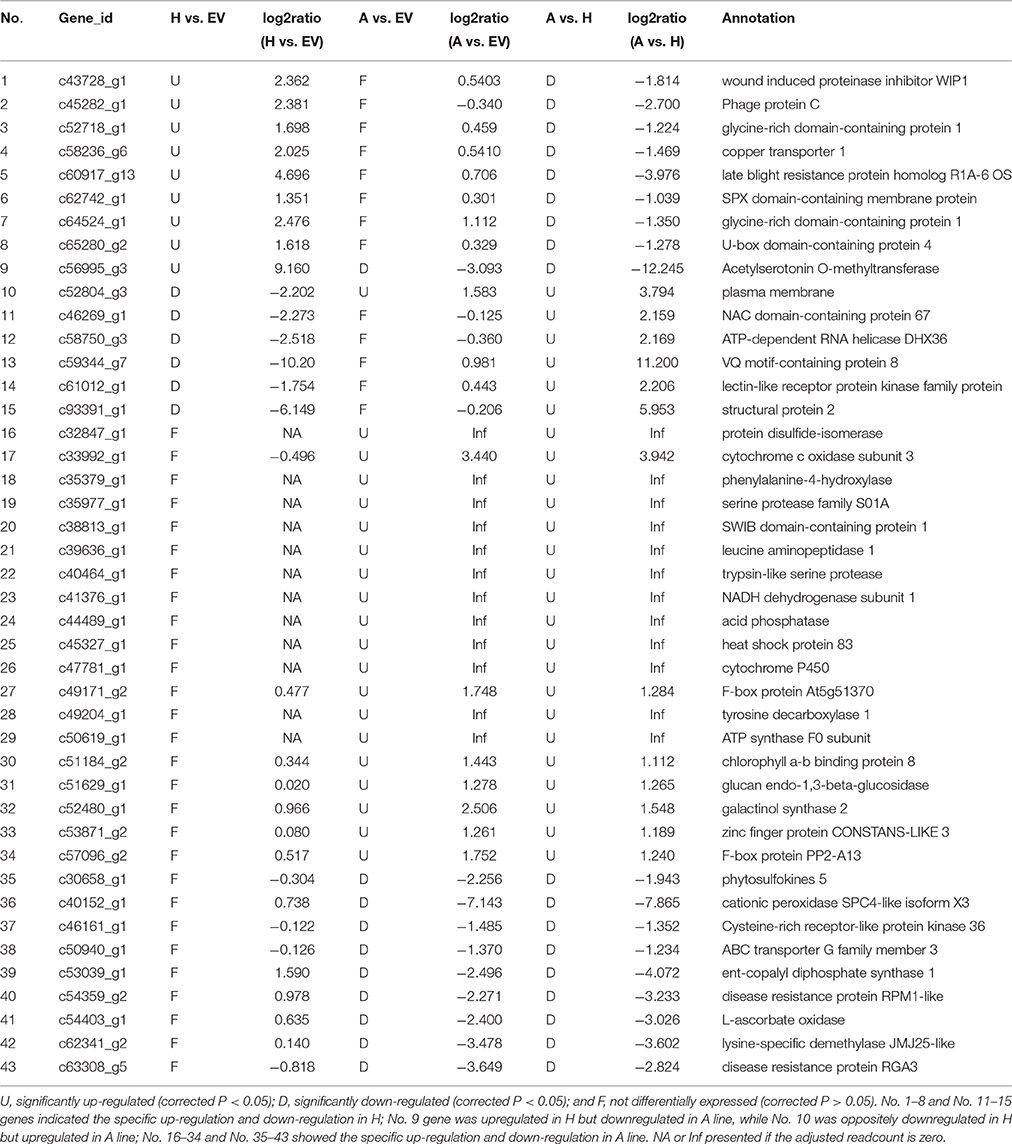
Table 1. The summary list of differentially expressed unigenes in transgenic oHIOMT (H), oAANAT (A), and empty vector (EV) lines.
Furthermore, the transgenic oHIOMT switchgrass exhibited earlier flowering than that of the EV, suggesting that the reproductive development was expedited by the endogenous addition of melatonin contents (Figure 1). The reduction and delay of flowering were reported under the exogenous melatonin treatment of Chenopodium rubrum (Kolář et al., 2003) and transgenic melatonin-rich rice (Byeon and Back, 2014), respectively. Melatonin is potentially involved in the regulation of flowering process by the similar pattern of the antioxidant ascorbic acid (Kotchoni et al., 2009) or the impediment of the floral transition from vegetative growth to reproductive growth by the repressor of gibberelic acid (GA) pathway (Shi et al., 2016b). However, other researches implied that melatonin was transiently induced with a peak level during flower development in rice (Park et al., 2013). In our study, one of the flowering regulator encoding gene APETALA2 significantly upregulated in transgenic oHIOMT line (log2FoldChange = 6.11 for c52062_g5, P < 0.01, Table 1) comparing with the EV control, which acts on the regulation of establishment of the floral meristem (Chen, 2004). The accumulation of melatonin represented the resistance for internal and external oxidative stress during reproductive development (Park et al., 2013).
Melatonin also plays innate immune responses to the complex of biotic and abiotic stresses in various plants species, dicots and monocots (Lee et al., 2014; Shi et al., 2015b; Hardeland, 2016). As summarized in recent publications, increases of melatonin were typically induced by diverse forms of stresses, including extreme temperatures, drought, salinity, and oxidant (Li et al., 2012; Zhang et al., 2014a; Fan et al., 2015). From our results, the overexpression of oHIOMT gene also drives a series of defense genes activated, for instance, c43076_g1 gene (annotated to “response to stress”) was significantly upregulated comparing with the EV (Supplementary File 1). In addition, the several amino acid and secondary metabolite related pathways were significantly upregulated, including flavonoid biosynthesis, tyrosine metabolism, beta-Alanine metabolism, glycine, serine, and threonine metabolism, brassinosteroid biosynthesis, phenylalanine metabolism, suggesting the activated growth and stress responses in transgenic oHIOMT lines (Supplementary File 2). Other researches exhibited similar tolerance to drought in transgenic MzASMT A. thaliana (Zuo et al., 2014), and the resistance to herbicide-induced oxidative damages in transgenic melatonin-rich rice (Park et al., 2012). The transcriptional regulation of defense genes alleviate the oxidative damages driven by various stresses (Wei et al., 2016).
Notably, the differentially expressed unigenes in HIOMT vs. EV (405) was less than those of AANAT vs. EV (946), suggesting that the overexpression of oAANAT could affect more growth-related genes than that of oHIOMT. In contrast, the significantly enriched pathways of the DEGs in HIOMT were more than those of AANAT, indicating that the alterations of involved processes driving by the O-methyltransferase were more complex (Figures 3, 5). The previous RNA-seq analysis of overexpression of oAANAT gene reported a large number of differentially expressed unigenes, which were majorly involved in various compound biosynthetic processes and organelle component (Yuan et al., 2016). Here, the synchronously upregulated transcriptional factors and growth related genes in transgenic oAANAT and oHIOMT implied the prompting roles of melatonin in plant growth and development comparing with EV. In addition, a number of differentially expressed genes specifically driving by transgenic oAANAT or oHIOMT potentially indicated the typical functions of each enzyme. For instance, several stress resistant related genes (SPX domain-containing membrane protein, copper transporter 1, late blight resistance protein homolog R1A-6 OS etc.) were specifically and significantly upregulated in transgenic oHIOMT only, while metabolism-related genes (phenylalanine-4-hydroxylase, tyrosine decarboxylase 1, protein disulfide-isomerase, and galactinol synthase 2 etc.) were significantly upregulated in transgenic oAANAT only (Table 1). The previous transgenic tomato represented the branching phenotype in overexpressing of oAANAT and oHIOMT and drought tolerance in transgenic oHIOMT lines (Wang et al., 2014). These indicated the both similarity and differences of the functions of the two key enzymes in the melatonin biosynthesis and metabolic networks. Furthermore, several researches regard the AANAT/SNAT is the rate-limiting enzyme during the melatonin biosynthesis (Morton and Forbes, 1988), while the other recent studies consider that the HIOMT/ASMT is the functional one (Byeon et al., 2015, 2016). The previous observation of the nearly two times of leaf melatonin level in oHIOMT line of transgenic tomato than those in oAANAT lines, provided the proof that ASMT, the homologous to HIOMT, was possibly the rate-limiting enzyme in plants (Wang et al., 2014). Although the similar patterns of the more melatonin accumulation and metabolic pathways were involved in the overexpression of the oHIOMT lines than those from the oAANAT ones in switchgrass seem to support the HIOMT is the rate-limiting enzyme (Figure 5), the large amount of KEGG pathways related to animal diseases possibly indicated the limited knowledge of melatonin functions in plants through the animal-oriented transgene. Therefore, further investigations from plant-oriented transgenic donor will be expected to provide valuable information for rate-limiting enzyme during the melatonin biosynthetic process.
The multiple membrane receptors and signal transduction mechanism were clarified in animals (Reppert et al., 1994). However, no high-affinity melatonin receptor was identified in plants to date (Park, 2011). Therefore, the receptor-independent mechanism of melatonin in plants was proposed as the neurons (Jan et al., 2011). In our study, the c58996_g3 unigene significantly downregulated (log2FoldChange = −1.768, padj < 0.01), which was annotated as G-protein coupled receptor signaling pathway by GO classification. The discrepancies between increasing melatonin contents and decreasing signaling receptor roughly sustain the hypothesis that melatonin might act via a receptor independent mechanism.
In conclusion, the transcriptomic data from transgenic oHIOMT gene switchgrass revealed amount of differentially expressed unigenes comparing with transgenic oAANAT and control lines, implying that the last step of catalytic reaction probably is the rate-limiting step during the melatonin biosynthesis in plants. The potential roles of melatonin in plants were indicated by the upregulation of a series of transcriptional factors and functional genes involving growth and resistance for various stresses. Moreover, additional experiments under adverse environmental stresses will confirm the melatonin physiological functions in plants. The definitions of the membrane receptors and signal transduction will largely drive the explanation of the melatonin biosynthesis processes and functional metabolic pathways.
Author Contributions
Conceived and designed the experiments: YZ and FY. Performed the experiments: SY, CG, SL, and YH. Analyzed the data: SY, CG, YH, XC, and DT. Wrote the paper: SY, CG, and YZ. All authors reviewed and approved the final manuscript.
Conflict of Interest Statement
The authors declare that the research was conducted in the absence of any commercial or financial relationships that could be construed as a potential conflict of interest.
Acknowledgments
Funding for this work was provided by the Ministry of Science and Technology, China (2014BAD23B03, 2012AA101801), National Natural Science Foundation of China (31272493), Natural Science Foundation of Beijing (6162016) and China Agricultural University (2014FG062).
Supplementary Material
The Supplementary Material for this article can be found online at: http://journal.frontiersin.org/article/10.3389/fpls.2016.01613/full#supplementary-material
References
Arnao, M. B., and Hernández-Ruiz, J. (2007). Melatonin promotes adventitious- and lateral root regeneration in etiolated hypocotyls of Lupinus albus L. J. Pineal Res. 42, 147–152. doi: 10.1111/j.1600-079X.2006.00396.x
Arnao, M. B., and Hernández-Ruiz, J. (2015). Function of melatonin in plants: a review. J. Pineal Res. 59, 133–150. doi: 10.1111/jpi.12253
Bai, C., Li, X., Gao, Y., Wang, K., Fan, Y., Zhang, S., et al. (2015). Role of microRNA-21 in the formation of insulin-producing cells from pancreatic progenitor cells. Biochim. Biophys. Acta Gene Regul. Mech. 1859, 280–293. doi: 10.1016/j.bbagrm.2015.12.001
Bai, C., Li, X., Gao, Y., Yuan, Z., Hu, P., Wang, H., et al. (2016). Melatonin improves reprogramming efficiency and proliferation of bovine-induced pluripotent stem cells. J. Pineal Res. 61, 154–167. doi: 10.1111/jpi.12334
Bouton, J. H. (2007). Molecular breeding of switchgrass for use as a biofuel crop. Curr. Opin. Genet. Dev. 17, 553–558. doi: 10.1016/j.gde.2007.08.012
Brown, C., Griggs, T., Holaskova, I., and Skousen, J. (2016). Switchgrass biofuel production on reclaimed surface mines: II. feedstock quality and theoretical ethanol production. Bioenerg. Res. 9, 40–49. doi: 10.1007/s12155-015-9657-3
Byeon, Y., and Back, K. (2014). An increase in melatonin in transgenic rice causes pleiotropic phenotypes, including enhanced seedling growth, delayed flowering, and low grain yield. J. Pineal Res. 56, 408–414. doi: 10.1111/jpi.12129
Byeon, Y., Choi, G. H., Lee, H. Y., and Back, K. (2015). Melatonin biosynthesis requires N-acetylserotonin methyltransferase activity of caffeic acid O-methyltransferase in rice. J. Exp. Bot. 66, 6917–6925. doi: 10.1093/jxb/erv396
Byeon, Y., Lee, H. J., Lee, H. Y., and Back, K. (2016). Cloning and functional characterization of the Arabidopsis N-acetylserotonin O-methyltransferase responsible for melatonin synthesis. J. Pineal Res. 60, 65–73. doi: 10.1111/jpi.12289
Chen, Q., Qi, W. B., Reiter, R. J., Wei, W., and Wang, B. M. (2009). Exogenously applied melatonin stimulates root growth and raises endogenous indoleacetic acid in roots of etiolated seedlings of Brassica juncea. J. Plant Physiol. 166, 324–328. doi: 10.1016/j.jplph.2008.06.002
Chen, X. (2004). A microRNA as a translational repressor of APETALA2 in Arabidopsis flower development. Science 303, 2022–2025. doi: 10.1126/science.1088060
Dubbels, R., Reiter, R. J., Klenke, E., Goebel, A., Schnakenberg, E., Ehlers, C., et al. (1995). Melatonin in edible plants identified by radioimmunoassay and by high performance liquid chromatography-mass spectrometry. J. Pineal Res. 18, 28–31. doi: 10.1111/j.1600-079X.1995.tb00136.x
Fan, J., Hu, Z., Xie, Y., Chan, Z., Chen, K., Amombo, E., et al. (2015). Alleviation of cold damage to photosystem ii and metabolisms by melatonin in Bermudagrass. Front. Plant Sci. 6:925. doi: 10.3389/fpls.2015.00925
Fu, C., Xiao, X., Xi, Y., Ge, Y., Chen, F., Bouton, J., et al. (2011). Downregulation of cinnamyl alcohol dehydrogenase (CAD) leads to improved saccharification efficiency in switchgrass. Bioenergy Res. 4, 153–164. doi: 10.1007/s12155-010-9109-z
Gao, Y. H., Bai, C. Y., Zheng, D., Li, C. L., Zhang, W. X., Li, M., et al. (2016). Combination of melatonin and Wnt-4 promotes neural cell differentiation in bovine amniotic epithelial cells and recovery from spinal cord injury. J. Pineal Res. 32, 147–152. doi: 10.1111/jpi.12311
Grabherr, M. G., Haas, B. J., Yassour, M., Levin, J. Z., Thompson, D. A., Amit, I., et al. (2011). Full-length transcriptome assembly from RNA-Seq data without a reference genome. Nat. Biotechnol. 29, 644–652. doi: 10.1038/nbt.1883
Hardeland, R. (2015). Melatonin in plants and other phototrophs: advances and gaps concerning the diversity of functions. J. Exp. Bot. 66, 627–646. doi: 10.1093/jxb/eru386
Hardeland, R. (2016). Melatonin in plants - diversity of levels and multiplicity of functions. Front. Plant Sci. 7:198. doi: 10.3389/fpls.2016.00198
Hardeland, R., and Poeggeler, B. (2003). Non-vertebrate melatonin. J. Pineal Res. 34, 233–241. doi: 10.1034/j.1600-079X.2003.00040.x
Hardin, C. F., Fu, C., Hisano, H., Xiao, X., Shen, H., Stewart, C. N., et al. (2013). Standardization of switchgrass sample collection for cell wall and biomass trait analysis. Bioenergy Res. 6, 755–762. doi: 10.1007/s12155-012-9292-1
Hattori, A., Migitaka, H., Iigo, M., Itoh, M., Yamamoto, K., Ohtani-Kaneko, R., et al. (1995). Identification of melatonin in plants and its effects on plasma melatonin levels and binding to melatonin receptors in vertebrates. Biochem. Mol. Biol. Int. 35, 627–634.
Hernández-Ruiz, J., Cano, A., and Arnao, M. B. (2005). Melatonin acts as a growth-stimulating compound in some monocot species. J. Pineal Res. 39, 137–142. doi: 10.1111/j.1600-079X.2005.00226.x
Jan, J. E., Reiter, R. J., Wong, P. K. H., Bax, M. C. O., Ribary, U., and Wasdell, M. B. (2011). Melatonin has membrane receptor-independent hypnotic action on neurons: an hypothesis. J. Pineal Res. 50, 233–240. doi: 10.1111/j.1600-079X.2010.00844.x
Kanehisa, M., Araki, M., Goto, S., Hattori, M., Hirakawa, M., Itoh, M., et al. (2008). KEGG for linking genomes to life and the environment. Nucl. Acids Res. 36, 480–484. doi: 10.1093/nar/gkm882
Kang, K., Lee, K., Park, S., Kim, Y. S., and Back, K. (2010). Enhanced production of melatonin by ectopic overexpression of human serotonin N-acetyltransferase plays a role in cold resistance in transgenic rice seedlings. J. Pineal Res. 49, 176–182. doi: 10.1111/j.1600-079x.2010.00783.x
Keshwani, D. R., and Cheng, J. J. (2009). Switchgrass for bioethanol and other value-added applications: a review. Bioresour. Technol. 100, 1515–1523. doi: 10.1016/j.biortech.2008.09.035
Kolář, J., Johnson, C. H., and Macháčková, I. (2003). Exogenously applied melatonin (N-acetyl-5-methoxytryptamine) affects flowering of the short-day plant Chenopodium rubrum. Physiol. Plant. 118, 605–612. doi: 10.1034/j.1399-3054.2003.00114.x
Kotchoni, S. O., Larrimore, K. E., Mukherjee, M., Kempinski, C. F., and Barth, C. (2009). Alterations in the endogenous ascorbic acid content affect flowering time in Arabidopsis. Plant Physiol. 149, 803–815. doi: 10.1104/pp.108.132324
Lee, H. Y., Byeon, Y., and Back, K. (2014). Melatonin as a signal molecule triggering defense responses against pathogen attack in Arabidopsis, and tobacco. J. Pineal Res. 57, 262–268. doi: 10.1111/jpi.12165
Lerner, A. B., Case, J. D., Takahashi, Y., Lee, Y., and Mori, W. (1958). Isolation of melatonin, the pineal gland factor that lightening melanocytes. J. Am. Chem. Soc. 81, 2587. doi: 10.1021/ja01543a060
Li, B., and Dewey, C. (2011). RSEM: accurate transcript quantification from RNA-Seq data with or without a reference genome. BMC Bioinform. 12, 93–99. doi: 10.1186/1471-2105-12-323
Li, C., Wang, P., Wei, Z., Liang, D., Liu, C., Yin, L., et al. (2012). The mitigation effects of exogenous melatonin on salinity-induced stress in Malus hupehensis. J. Pineal Res. 53, 298–306. doi: 10.1111/j.1600-079X.2012.00999.x
Liu, S. J., Huang, Y. H., Chang-Jiu, H. E., Cheng, F., and Zhang, Y. W. (2016). Cloning, bioinformatics and transcriptional analysis of caffeoyl-coenzyme a 3-O-methyltransferase in switchgrass under abiotic stress. J. Integr. Agr. 15, 636–649. doi: 10.1016/S2095-3119(16)61363-1
Livak, K. J., and Schmittgen, T. D. (2001). Analysis of relative gene expression data using real-time quantitative PCR and the 2-ΔΔCT method. Methods 25, 402–408. doi: 10.1006/meth.2001.1262
Manchester, L. C., Tan, D. X., Reiter, R. J., Park, W., Monis, K., and Qi, W. (2000). High levels of melatonin in the seeds of edible plants: the seed of edible plants: possible function in germ tissue protection. Life Sci. 67, 3023–3029. doi: 10.1016/S0024-3205(00)00896-1
Mao, X., Cai, T., Olyarchuk, J. G., and Wei, L. (2005). Automated genome annotation and pathway identification using the KEGG Orthology (KO) as a controlled vocabulary. Bioinformatics 21, 3787–3793. doi: 10.1093/bioinformatics/bti430
McLaughlin, S. B., and Kszos, L. A. (2005). Development of switchgrass (Panicum virgatum) as a bioenergy feedstock in the United States. Biomass Bioenergy 28, 515–535. doi: 10.1016/j.biombioe.2004.05.006
Morton, D. J., and Forbes, H. J. (1988). Pineal gland N-acetyltransferase and hydroxyindole-O-methyltransferase activity in the rainbow trout (Salmo gairdneri): seasonal variation linked to photoperiod. Neurosci. Lett. 94, 333–337. doi: 10.1016/0304-3940(88)90040-7
Murch, S. J., Campbell, S. S. B., and Saxena, P. K. (2001). The role of serotonin and melatonin in plant morphogenesis: regulation of auxin-induced root organogenesis in in vitro -cultured explants of St. John's Wort (Hypericum perforatum L.). In vitro Cell. Dev. Biol. 37, 786–793. doi: 10.1007/s11627-001-0130-y
Okazaki, M., Higuchi, K., Aouini, A., and Ezura, H. (2010). Lowering intercellular melatonin levels by transgenic analysis of indoleamine 2,3-dioxygenase from rice in tomato plants. J. Pineal Res. 49, 239–247. doi: 10.1111/j.1600-079X.2010.00788.x
Park, S., Lee, D. E., Jang, H., Byeon, Y., Kim, Y. S., and Back, K. (2012). Melatonin-rich transgenic rice plants exhibit resistance to herbicide-induced oxidative stress. J. Pineal Res. 54, 258–263. doi: 10.1111/j.1600-079X.2012.01029.x
Park, S., Le, T. N., Byeon, Y., Kim, Y. S., and Back, K. (2013). Transient induction of melatonin biosynthesis in rice (Oryza sativa L.) during the reproductive stage. J. Pineal Res. 55, 40–45. doi: 10.1111/jpi.12021
Park, W. J. (2011). Melatonin as an endogenous plant regulatory signal: debates and perspectives. J. Plant Biol. 54, 143–149. doi: 10.1007/s12374-011-9159-6
Poovaiah, C. R., Mazarei, M., Decker, S. R., Turner, G. B., Sykes, R. W., Davis, M. F., et al. (2014). Transgenic switchgrass (Panicum virgatum L.) biomass is increased by overexpression of switchgrass sucrose synthase (PvSUS1). Biotechnol. J. 10, 552–563. doi: 10.1002/biot.201400499
Reiter, R. J., Tan, D. X., Zhou, Z., Cruz, M. H. C., Fuentes-Broto, L., and Galano, A. (2015). Phytomelatonin: assisting plants of survive and thrive. Molecules 20, 7396–7437. doi: 10.3390/molecules20047396
Reppert, S. M., Weaver, D. R., and Ebisawa, T. (1994). Cloning and characterization of a mammalian melatonin receptor that mediates reproductive and circadian responses. Neuron 13, 1177–1185. doi: 10.1016/0896-6273(94)90055-8
Sarropoulou, V., Dimassi-Theriou, K., Therios, I., and Koukourikou-Petridou, M. (2012). Melatonin enhances root regeneration, photosynthetic pigments, biomass, total carbohydrates and proline content in the cherry rootstock PHL-C (Prunus avium × Prunus cerasus). Plant Physiol. Bioch. 61, 162–168. doi: 10.1016/j.plaphy.2012.10.001
Sharma, M. K., Sharma, R., Cao, P., Harkenrider, M., Jenkins, J., Grimwood, J., et al. (2015). Targeted switchgrass BAC library screening and sequence analysis identifies predicted biomass and stress response-related genes. Bioenergy Res. 9, 1–14. doi: 10.1007/s12155-015-9667-1
Shen, H., Poovaiah, C. R., Ziebell, A., Tschaplinski, T. J., Pattathil, S., Gjersing, E., et al. (2013). Enhanced characteristics of genetically modified switchgrass (Panicum virgatum L.) for high biofuel production. Biotechnol. Biofuels 6, 4770–4776. doi: 10.1186/1754-6834-6-71
Shi, H., Chen, K., Wei, Y., and He, C. (2016a). Fundamental issues of melatonin-mediated stress signaling in plants. Front. Plant Sci. 7:1124. doi: 10.3389/fpls.2016.01124
Shi, H., Qian, Y. Q., Tan, D. X., Reiter, R. J., and He, C. (2015b). Melatonin induces the transcripts of CBF/DREB1s, and their involvement in both abiotic and biotic stresses in Arabidopsis. J. Pineal Res. 59, 334–342. doi: 10.1111/jpi.12262
Shi, H., Tan, D. X., Reiter, R. J., Ye, T., Yang, F., and Chan, Z. (2015a). Melatonin induces class a1 heat shock factors (HSFA1s) and their possible involvement of thermotolerance in Arabidopsis. J. Pineal Res. 58, 335–342. doi: 10.1111/jpi.12219
Shi, H., Wei, Y., Wang, Q., Reiter, R. J., and He, C. (2016b). Melatonin mediates the stabilization of DELLA proteins to repress the floral transition in Arabidopsis. J. Pineal Res. 60, 373–379. doi: 10.1111/jpi.12320
Simopoulos, A. P., Tan, D. X., Manchester, L. C., and Reiter, R. J. (2005). Purslane: a plant source of omega-3 fatty acids and melatonin. J. Pineal Res. 39, 331–332. doi: 10.1111/j.1600-079X.2005.00269.x
Sun, G. L., Stewart, C. N. Jr., Xiao, P., and Zhang, B. H. (2012). MicroRNA expression analysis in the cellulosic biofuel crop switchgrass (Panicum virgatum) under abiotic stress. PLoS ONE 7:e32017. doi: 10.1371/journal.pone.0032017
Tan, D. X., Hardeland, R., Back, K., Manchester, L. C., Alatorre-Jimenez, M. A., and Reiter, R. J. (2016). On the significance of an alternate pathway of melatonin synthesis via 5-methoxytryptamine: comparisons across species. J. Pineal Res. 61, 27–40. doi: 10.1111/jpi.12336
Wang, L., Zhao, Y., Reiter, R. J., He, C., Liu, G., Lei, Q., et al. (2014). Changes in melatonin levels in transgenic ‘Micro-Tom’ tomato overexpressing ovine AANAT, and ovine HIOMT genes. J. Pineal Res. 56, 134–142. doi: 10.1111/jpi.12105
Wei, W., Li, Q. T., Chu, Y. N., Reiter, R. J., Yu, X. M., Zhu, D. H., et al. (2015). Melatonin enhances plant growth and abiotic stress tolerance in soybean plants. J. Exp. Bot. 66, 695–707. doi: 10.1093/jxb/eru392
Wei, Y., Zeng, H., Wei, H., Chen, L., He, C., and Shi, H. (2016). Comparative transcriptional profiling of melatonin synthesis and catabolic genes indicates the possible role of melatonin in developmental and stress responses in rice. Front. Plant Sci. 7:676. doi: 10.3389/fpls.2016.00676
Wuddineh, W. A., Mazarei, M., Turner, G. B., Sykes, R. W., Decker, S. R., Davis, M. F., et al. (2015). Identification and molecular characterization of the switchgrass AP2/ERF transcription factor superfamily, and overexpression of PvERF001 for improvement of biomass characteristics for biofuel. Front. Bioeng. Biotechnol. 3:101. doi: 10.3389/fbioe.2015.00101
Yang, J., Worley, E., Torres-Jerez, I., Miller, R., Wang, M., Fu, C., et al. (2014). PvNAC1, and PvNAC2, are associated with leaf senescence and nitrogen use efficiency in switchgrass. Bioenergy Res. 8, 868–880. doi: 10.1007/s12155-014-9566-x
Young, M. D., Wakefield, M. J., Smyth, G. K., and Oshlack, A. (2010). Gene ontology analysis for RNA-seq: accounting for selection bias. Genome Biol. 11, 1–14. doi: 10.1186/gb-2010-11-2-r14
Yuan, S., Huang, Y. H., Liu, S., Guan, C., Cui, X., Tian, D. Y., et al. (2016). RNA-seq analysis of overexpressing ovine AANAT gene of melatonin biosynthesis in switchgrass. Front. Plant Sci. 7:1289. doi: 10.3389/fpls.2016.01289
Zhang, H. J., Zhang, N., Yang, R. C., Wang, L., Sun, Q. Q., Li, D. B., et al. (2014a). Melatonin promotes seed germination under high salinity by regulating antioxidant systems, ABA and GA 4, interaction in cucumber (Cucumis sativus L.). J. Pineal Res. 57, 269–279. doi: 10.1111/jpi.12167
Zhang, L. J., Jia, J. F., Xu, Y., Wang, Y., Hao, J. G., and Li, T. K. (2012). Production of transgenic Nicotiana sylvestris plants expressing melatonin synthetase genes and their effect on UV-B-induced DNA damage. In Vitro Cell. Dev. Biol. Plant 48, 275–282. doi: 10.1007/s11627-011-9413-0
Zhang, N., Sun, Q., Zhang, H., Cao, Y., Weeda, S., Ren, S., et al. (2014b). Roles of melatonin in abiotic stress resistance in plants. J. Exp. Bot. 66, 647–656. doi: 10.1093/jxb/eru336
Zhang, N., Zhang, H. J., Zhao, B., Sun, Q. Q., Cao, Y. Y., Li, R., et al. (2014c). The RNA-seq approach to discriminate gene expression profiles in response to melatonin on cucumber lateral root formation. J. Pineal Res. 56, 39–50. doi: 10.1111/jpi.12095
Zhao, Y., Tan, D. X., Lei, Q., Chen, H., Wang, L., Li, Q. T., et al. (2013). Melatonin and its potential biological functions in the fruits of sweet cherry. J. Pineal Res. 55, 79–88. doi: 10.1111/jpi.12044
Keywords: switchgrass, melatonin, transgene, oHIOMT, RNA-seq
Citation: Yuan S, Guan C, Liu S, Huang Y, Tian D, Cui X, Zhang Y and Yang F (2016) Comparative Transcriptomic Analyses of Differentially Expressed Genes in Transgenic Melatonin Biosynthesis Ovine HIOMT Gene in Switchgrass. Front. Plant Sci. 7:1613. doi: 10.3389/fpls.2016.01613
Received: 12 September 2016; Accepted: 12 October 2016;
Published: 08 November 2016.
Edited by:
Haitao Shi, Hainan University, ChinaReviewed by:
Chunyu Bai, Chinese Academy of Agricultural Sciences, ChinaJidi Xu, Northwest A&F University, China
Copyright © 2016 Yuan, Guan, Liu, Huang, Tian, Cui, Zhang and Yang. This is an open-access article distributed under the terms of the Creative Commons Attribution License (CC BY). The use, distribution or reproduction in other forums is permitted, provided the original author(s) or licensor are credited and that the original publication in this journal is cited, in accordance with accepted academic practice. No use, distribution or reproduction is permitted which does not comply with these terms.
*Correspondence: Yunwei Zhang, zywei@126.com
Fuyu Yang, yfuyu@cau.edu.cn
†These authors have contributed equally to the work.
 Shan Yuan
Shan Yuan Cong Guan1†
Cong Guan1†